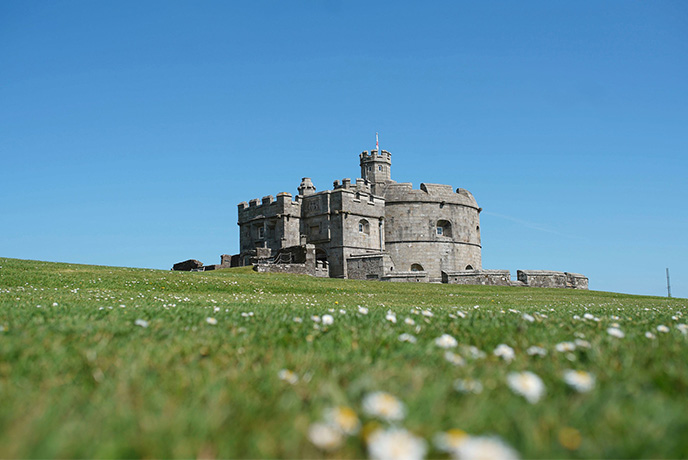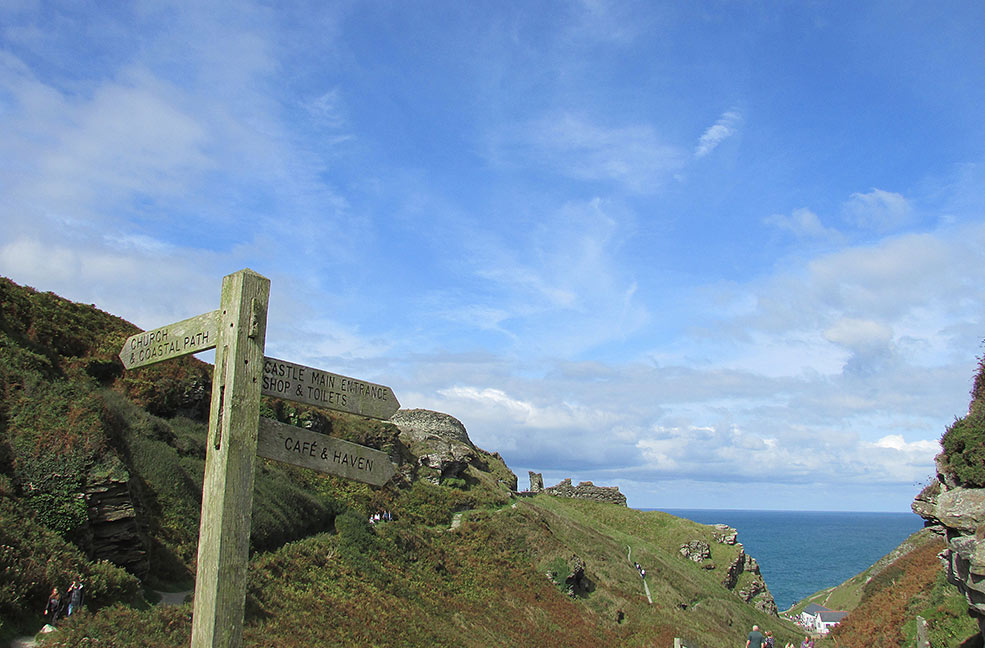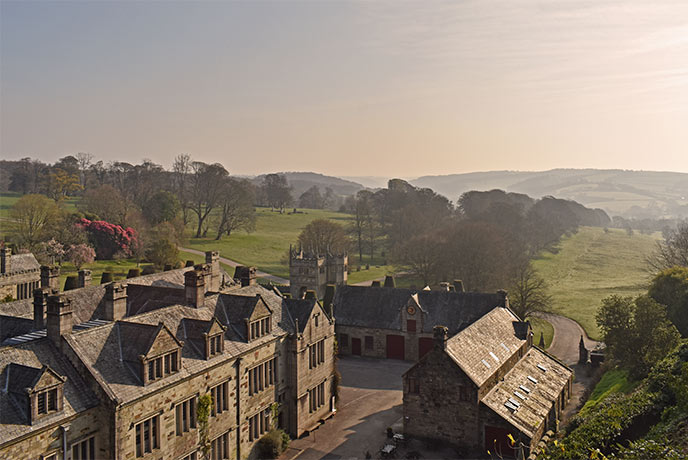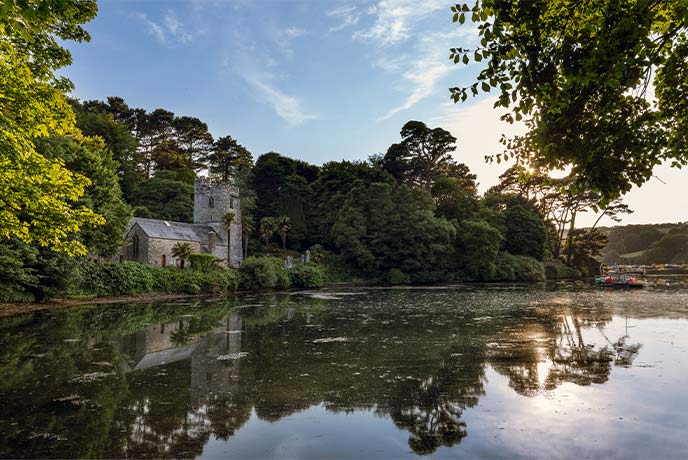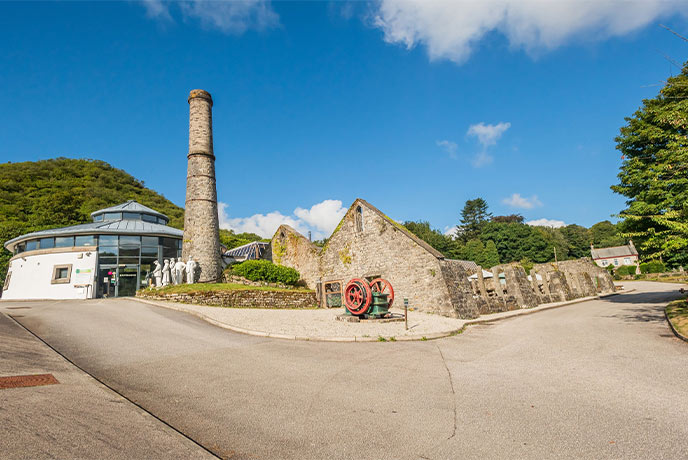On the fringes of England, Cornwall is a frontier and the first and last port of call for friend and foe. As a consequence, since the earliest times the Cornish people have built castles to protect themselves and to make a statement to anyone planning to attack this corner of the country.
Historically, Cornwall’s castles can be divided into three main stages – the Iron Age hillforts and prehistoric cliff castles built before the arrival of the Romans, the Norman castles dating from the 11th century onwards and the magnificent Tudor coastal defences constructed during the 16th century.
Each castle, perfectly positioned to defend its particular margin of Cornwall, is unique and has its own fascinating story to tell. Whether it is a tale of civil war courage, the romance of Arthurian legend or the mystery of antiquity, Cornwall’s castles are bursting with history and exploring them takes us to some of the most impressive and beautiful positions in the region.
Our guide covers the exciting and beautiful castles of Cornwall from Norman strongholds such as Launceston castle and fairy-tale fortresses like St Michael’s Mount to the haunted gothic tower of Pengersick.
Top Tip: Membership of Cornwall Heritage Trust gives you free entry to all English Heritage sites in Cornwall as well as discounts to other attractions!
Castles in North Cornwall
Launceston Castle, Launceston 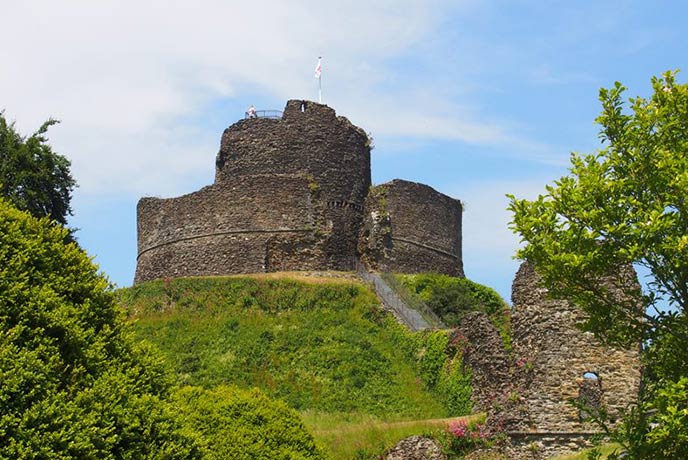
Launceston Castle was the first Norman castle to be erected in Cornwall by Robert of Mortain, Earl of Cornwall, in the 1070s and today is without doubt one of the finest castles in Cornwall. Towering over the town on its high artificial mound the strong circular keep survives as a reminder of the past power and authority of the Earls and Dukes of Cornwall.
There was fighting here during the civil war which saw the little fortress pass back and forth between Royalist and Parliamentarian forces. When Launceston castle fell out of use its courtyard and some of the buildings were used as a prison between the 17th and 19th centuries, with famous prisoners including the founder of the Quaker religion, George Fox who was arrested in 1656. The last hanging in Launceston took place inside the bailey in 1821.
This evocative castle is now cared for by English Heritage and makes a wonderful place to explore, somewhere where imaginations can really run wild surrounded by so much brooding history!
Tintagel Castle, Tintagel
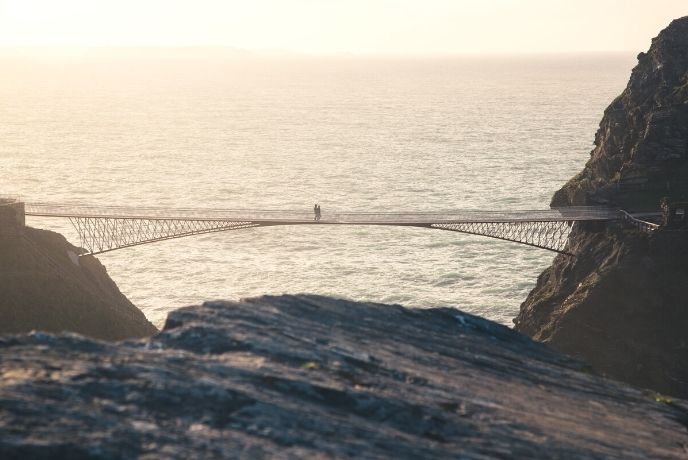
Reputedly the birthplace of the legendary King Arthur, Tintagel Castle is an island stronghold bursting with more than 1000 years of history. Probably the most famous castle in Cornwall with so much to explore, it makes a wonderful day out for families.
It is likely that this headland site has seen human occupation from the Iron Age onwards, but from about the 5th century Tintagel was the royal citadel of the Cornish kings and an international trading port. Pottery imported from as far away as Greece, Turkey and Tunisia has been found here.
The castle has long been connected to the Cornish King Mark and the legends of the star-crossed lovers Tristan and Iseult as well as the legendary King Arthur, whose statue can be seen on the headland, and the wizard Merlin. Much of the castle that we see today was built by Richard, Earl of Cornwall, one of the richest men in Europe in the 13th century.
The spectacular bridge, which spans the gorge dividing the castle from the mainland, makes an exciting entrance to a site that is both wildly beautiful and historically unique. There are some stunning walks in the area that take in this historic sight (some with beckoning pub stops) so why not lace up the old walking boots for a walk with a difference.
Restormel Castle, Lostwithiel
Restormel Castle is a majestic ring of stone crowning a steep hill that rises from the banks of the River Fowey. With circular walls nearly 3 metres thick surrounded by a deep moat it is one of the most remarkable castles in Cornwall and the views from its well preserved battlements of the surrounding countryside are breath-taking.
It is unclear when the first castle was built on this site but it is thought that a Norman nobleman Baldwin FitzTurstin may have built himself a fort here in around 1100. This was then converted to stone and improved by his descendants who held the castle for the next 200 years. Much of the interior that we see today was added in the 13th century by Edmund, Earl of Cornwall who used it less as a defensive structure and more as a homely retreat with large fireplaces, a great hall, chapel and large windows to take in those views. But this was always a strategic location given its proximity to a crossing point in the River Fowey and the Stannary town of Lostwithiel which was once at the centre of Cornwall’s tin trade.
Edward, the Black Prince is said to have spent time here but the castle never really saw any real fighting. During an excavation of the moat in the 18th century it is said that two large skeletons were uncovered, locked in each other arms, giving rise to all kinds of romantic notions as to how they came to be there. According to records they were reburied where they lay.
The nearby town of Lostwithiel is famed for its antique shops and has plenty of cafes to enjoy a spot of lunch or perhaps a picnic beside its peaceful river and magnificent 15th century bridge.
Check out our complete guide to North Cornwall for more holiday inspiration!
Castles in South Cornwall
Pendennis Castle, Falmouth
Standing high on a headland guarding the mouth of Falmouth harbour, Pendennis Castle occupies a spectacular vantage point. It was part of a chain of castles built by Henry VIII between 1539 and 1545 to protect the south coast from invasion. Expanded during the reign of Elizabeth I and again during more recent conflicts, this castle played a part in the defence of Britain up until the 1950s.
One of the more dramatic episodes of its history took place during the Civil War. King Charles’ wife Henriette stayed at Pendennis before fleeing to France. In 1646 the Parliamentarian forces laid siege to the castle and John Arundell, along with the 1000 men camped inside the walls, held out for five months until starvation forced their surrender.
Visitors can expect to see displays covering all aspects of this castle’s history right from its Tudor construction to its action during World War II. There are also some beautiful walks and beaches close by and a stroll along the front to Gyllynvase is rewarded by a tasty treat from the popular beach café.
St Mawes Castle, The Roseland
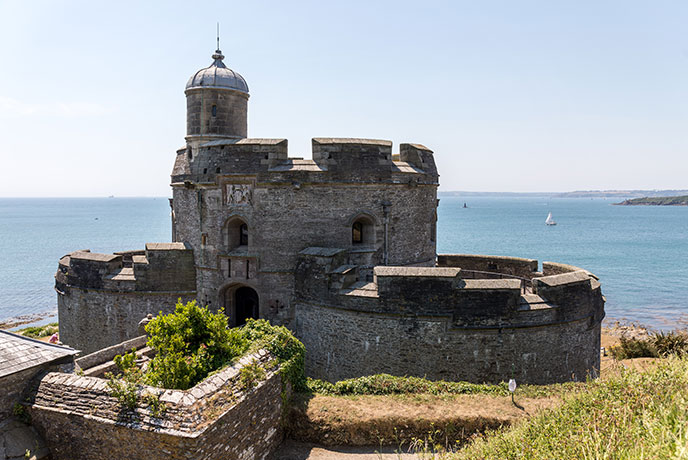
St Mawes castle on the Roseland Peninsula is the sister castle to Pendennis just across the water and was also built by King Henry VIII to protect the important anchorage of the Carrick Roads. It is better preserved and more original than Pendennis however.
This little fortress is an archetypal Tudor stronghold; shaped like the clover, one of its unique features is its decorative stonework including inscriptions in praise of King Henry and his son Edward. There are many magnificent cannons here too and it is said that these were often fired for practice across the bay, trying to hit Black Rock which juts up through the water mid-channel. Divers still bring up cannonballs from the seabed to this day.
There are stunning views from the battlements, but deep in the belly of the castle it is also possible to visit the oubliette, a secret dungeon where prisoners were once held.
A fun way to visit St Mawes is by ferry from Falmouth and this ride across the bay, which is often accompanied by dolphins, is a wonderful adventure in itself.
Caerhays Castle, Gorran Churchtown
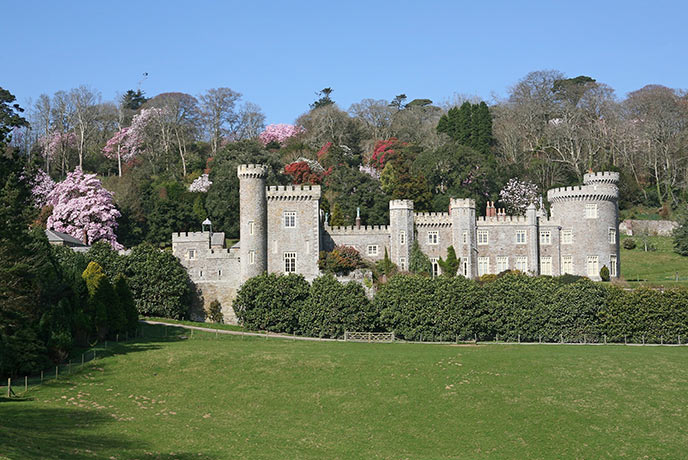
Built by John Nash, the famous Regency architect, Caerhays castle was completed in 1810. It is by far the most modern of the castles in our guide but Nash took inspiration from Norman architecture and the estate itself has a history dating back to the Middle Ages.
Caerhays’ elegant and extensive gardens are world renowned. Famously the Williams family, the owners since 1854, employed an army of Cornish miners to remove the top of a hill because it was blocking the castle’s view of the sea. These days Caerhays is perhaps best known for its spectacular magnolias, it holds the National Collection, and in spring and summer the gardens are a riot of colour.
The castle is also within easy reach of the stunning Porthluney Bay, a family friendly beach where the Caerhays Beach Cafe serves up excellent food and relaxing views.
St Catherine’s Castle, Fowey
This little castle is one of a pair of artillery forts built by King Henry VIII in the 1530s during the ongoing hostilities with France and Spain. St Catherine’s along with Polruan Castle on the opposite side of the water were positioned to protect the important boat-building harbour town of Fowey which had already been attacked in the 1450s by French pirates. Legend has it that a heavy chain was slung between the two forts which could be raised to stop enemy ships entering the narrow waterway.
Records show that the two castles were repaired and brought back into service on various occasions for the next roughly 300 years, during the Civil War, Crimean War and then were last used during World War II when a boom was again stretched between St Catherine’s and Polruan castle. Soldiers and anti-aircraft guns were also positioned on St Catherine’s old Crimean War gun emplacements for the duration of the conflict.
Fowey is a truly fascinating historic town with a tangle of streets along the waterfront. Frequent ferries make the short crossing to Polruan if you fancy visiting the other castle and getting a different perspective, and there are also interesting boat tours around the harbour during the summer months.
Find out more about things to do in South Cornwall.
Castles in West Cornwall
St Michael’s Mount, Marazion
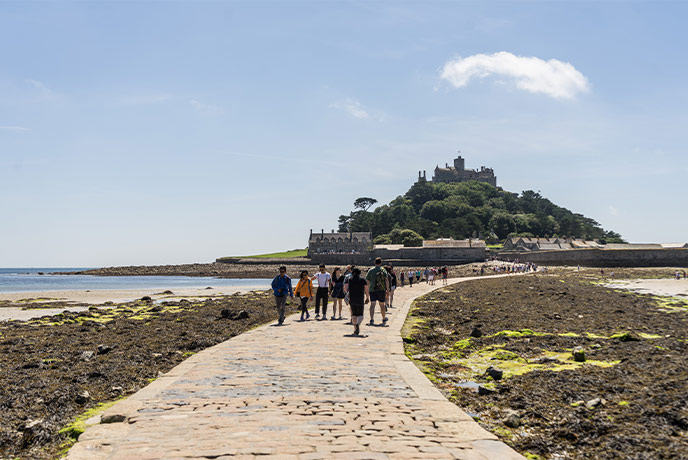
The view of this picturesque tidal island has to be one of the most iconic in Cornwall. But this fairytale castle in fact started life as a monastery, built by monks in the early 12th century.
A place famed for myth and legend, St Michael’s Mount’s history is also complex. Its Cornish name, Carreg Loos an Coos, which means ‘Grey Rock in the Forest’, tells of a time before written record when the sea levels here were much lower and this rocky outcrop was far from the sea. Then around 3000 years ago the island was known as ‘Ictis’, a trading port for the Phoenicians who came in search of tin. It became a place of Christian pilgrimage and then a stronghold during the War of the Roses and the civil war. But it was during the reign of King Henry VIII that the Mount really went from being a place of religious significance to a military fortress.
Whether you cross to this wonderful place via the ancient granite causeway or by boat, it always feels like a real adventure. This is a very special castle that feels a world apart from the bustle of the mainland and looking out across the sweeping bay from the battlements is a timeless and evocative experience.
Chun Castle, Penwith
Chun Castle is one of the finest Iron Age hill forts in Cornwall. Built around 2,500 years ago, it occupies a breath-taking hilltop location that offers extensive views of Penwith. This impressive roughly circular fort consists of two rings of tumbled stone walls which once stood 5m high until much of the stone was robbed to build Madron workhouse in the 19th century. Built as a defensive structure by a local tribe, legend has it that this place is a haunt for Cornish piskies!
The castle stands next to an ancient trackway, known as the Tinner’s Way, which was used in prehistory to move tin from Cape Cornwall to St Ives and beyond. This whole area is dotted with archaeological remains including the dramatic Chun Quoit and the famous Men-an-tol holed stone. There are numerous walking opportunities around the castle, with panoramic views, and it’s a great starting point from which to discover the rest of this wild region of Cornwall.
Pengersick Castle, Praa Sands
Reputedly one of the most haunted locations in Cornwall, the gothic tower of Pengersick Castle is now a popular wedding venue set within beautiful flower-filled gardens.
Though there has been a manor on the site since the 12th century, the present castle was built during the 16th and is rumoured to have been paid for with bounty from a wrecked Portuguese treasure ship. The medieval tower house is one of just a handful of its type that survive in Britain.
Stories of murders, poisonings and tragic accidents all add to the atmosphere of this intriguing place but the castle is much more than a spooky sideshow, this is a truly historic building packed with relics from its illustrious past.
Pengersick is just a short walk from the golden stretch of Praa Sands beach and there is ample opportunity for coastal walking in this beautiful less well known corner of Cornwall.
Discover more about West Cornwall.
Ready to get your history cap on? Explore Cornish castles from one of our lovely holiday cottages in Cornwall and discover everything there is to know about this beautiful county's heritage.


